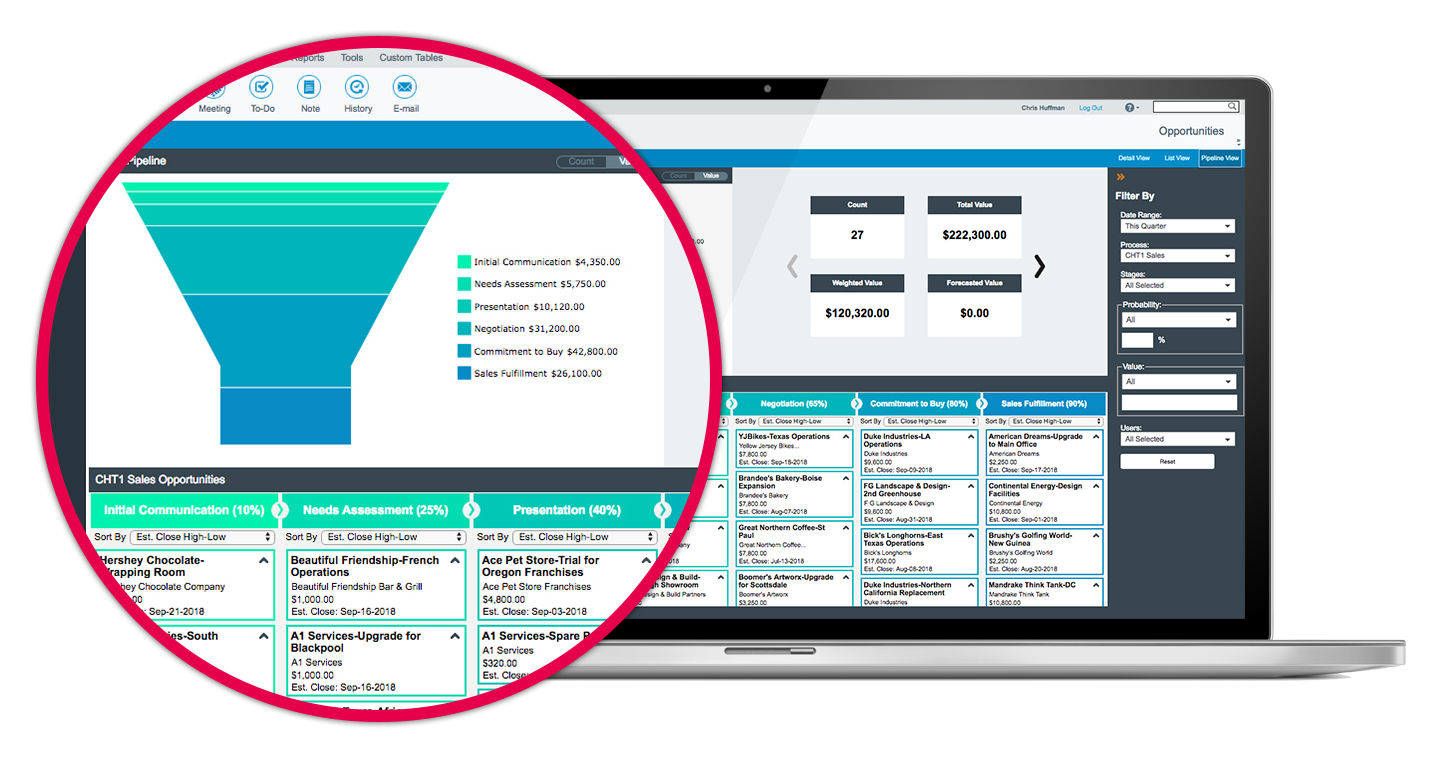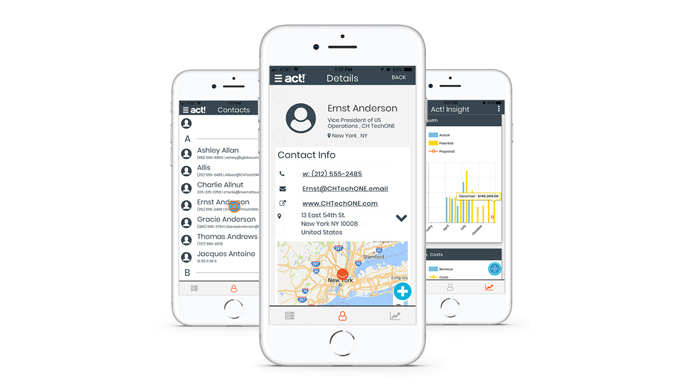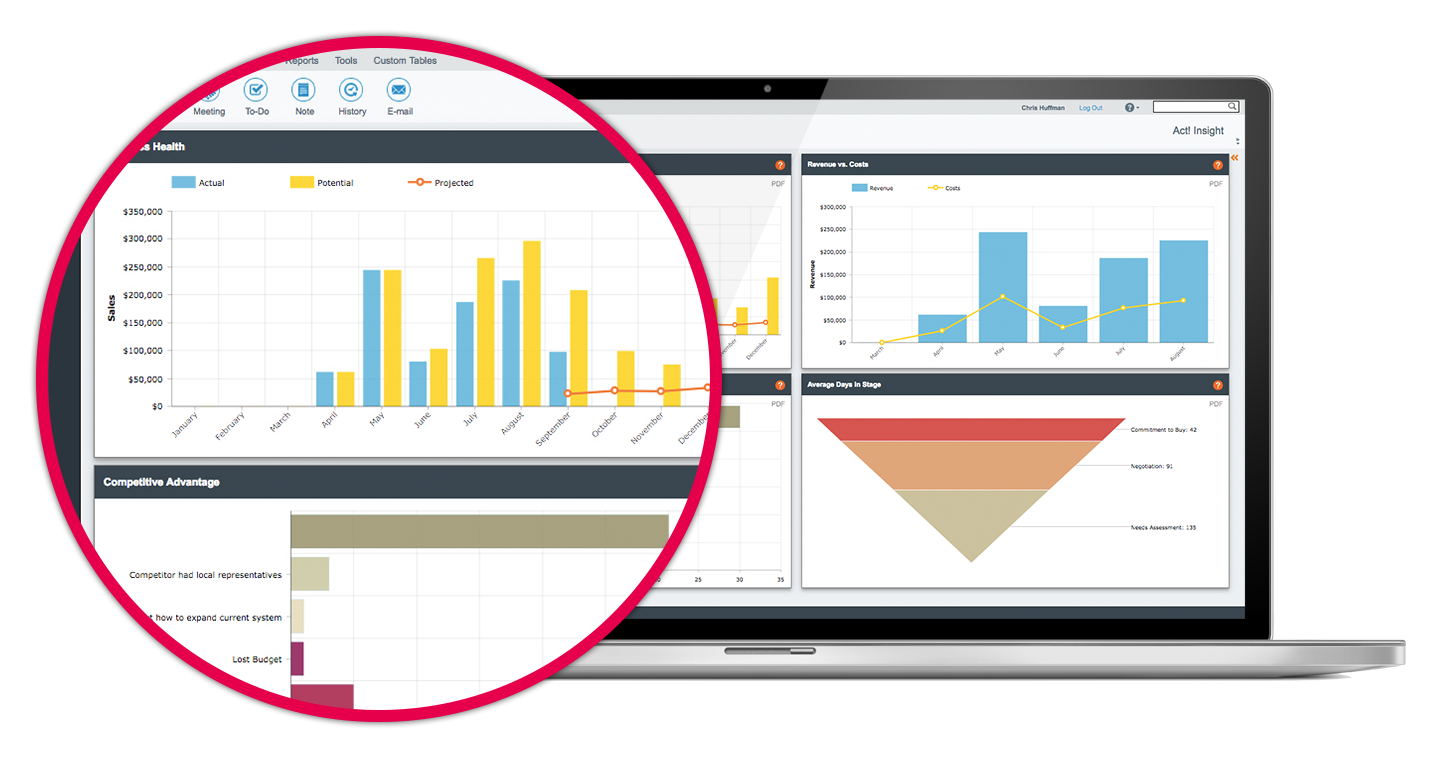Build efficient sales processes and improve your team’s performance
Act! sales CRM offers a rich and advanced set of features designed to help sales teams store contact details and sales records, easily manage their sales pipeline, produce key sales metrics and projections, and automate their sales process.

Sales Pipeline Management
Easily manage opportunities and close deals faster with dynamic sales pipeline management tools. Gain an understanding of how effective your sales strategy is and how you can improve it.
Sales CRM App
Access your prospects’ details whenever you need them. With the Act! sales CRM mobile app you can easily create, update, and close opportunities from anywhere, because your sales pipeline is always at your fingertips.


Sales Reporting & Forecasting
Benefit from the powerful sales reporting and analytics features. Monitor key sales metrics and make informed decisions based on accurate sales projections.
Why Act! for your sales reps?
- Manage contact details, calendar information and sales records in one place
- Easily manage leads and see where each opportunity is in your sales pipeline
- Make smarter decisions with in-depth sales reporting and analytics
- Close deals from anywhere with the sales CRM mobile app
- Automate your sales process and increase your reps’ productivity
- Benefit from expert technical support1
Take a free 14 day trial of Act!.
Sales CRM FAQ
Choosing the right sales CRM for your sales team can be challenging. Please find below some frequently asked questions that can make the choice easier for you.
Sales CRM software helps businesses manage relationships with prospects, leads, and customers. This can ultimately lead to improved sales team performance and more revenue for a business. Here are five ways CRM helps sales.
- Increase sales team productivity. CRM software has been found to increase sales productivity by up to 34%. Having all the information about each contact in one place means sales reps know exactly where to find everything they need to build sales. Additionally, sales force automations within the CRM reduce the amount of administrative work reps need to do while ensuring all important details are recorded.
- Help nurture leads through the sales process. Sales teams can use a CRM to find out exactly where prospects are in the sales process. This makes it easy for reps to see which steps they need to take next. Additionally, managers can assign tasks to reps from within the CRM, ensuring the required next step is always being take
- Tailor sales pitches based on information in the CRM. Having easy access to in-depth information allows sales reps to tailor their sales efforts. This can help when making sale
- Provide in-depth reporting and analytics. CRMs with reporting and analytics features help sales managers see how their team is performing. They can see what is going well, as well as what needs improving. This allows them to make changes to sales strategy which can make the process more effective.
- Grow sales. Ultimately, all the above help sales teams with their main goal; to increase sales and build revenue. Reports suggest using a CRM can increase sales by up to 29 per cent.
Sales CRM software has many features designed to help sales teams build efficient sales processes. Here is a look at some of the features of a sales CRM.
Contact management
This is the basic feature of CRM. Sales teams can create an entry for each customer within the CRM and store information about them. This includes contact details, calendar information, sales records (if they are already customers) and the ability to add notes.
Many also integrate with your email client so teams can keep a record of communication with clients. Others allow you to store documents in the CRM such as invoices and sales records.
Sales pipeline management
CRM software often includes a view of your sales pipeline that allows sales teams to easily manage leads and see where each contact is on their sales pipeline. Having a sales pipeline view also allows businesses to gain an understanding of how effective their sales strategy is and where there might be issues in the process.
Reporting and analytics
Many CRM providers include powerful reporting and analytics features. Those that can automatically produce easy-to-read reports allow managers to see how a sales team is performing and take steps to improve this where necessary.
Additionally, key sales metrics and projections can be shared throughout a company, allowing strategists to make decisions based on accurate predictions of metrics such as sales or revenue.
Sales automation
CRM software often comes with sales automation features. These automations free up time for reps to focus on other tasks while ensuring the most effective sales actions are taken at each step of the process.
For example, reps can set up the CRM to automatically send follow-up emails to prospects when a certain action is taken. Alternatively, the CRM can prioritise leads within the CRM based on marketing campaign results, thereby ensuring reps focus on the prospects that are most likely to lead to sales.
The best CRM for sales reps is the one that they use. It’s the one fits seamlessly into their day-to-day tasks and, ultimately, make selling easier. Here are some things that can help with that:
Easy to use
People can be creatures of habit and many sales teams and reps already have their own way of doing things.
It is therefore crucial that when companies implement a new CRM it is as easy to use as possible. The steeper the learning curve, the more time sales teams will have to spend getting used to the product. This will take away from time spent making sales.
Work with tools you already use
Many sales teams use a large number of apps and services to support their sales efforts. The best CRM platforms integrate with these third-party products, allowing sales teams to streamline their processes.
For example, sales teams can integrate their CRM with ecommerce solutions so each of a customer’s transactions shows up in their record. Alternatively, you could link the CRM to a form on your website so that it makes a new CRM record every time a new prospect requests information.
The better your CRM works with your existing tools, the easier it will fit into your sales team’s existing workflows.
Accessible where and when your sales team needs it
Cloud-based CRMs allow sales employees access wherever they are based. They could check an entry on their phone on the way to a presentation using a CRM mobile app, or access the CRM from their home computer in the evening.
Likewise, being cloud-based means all updates are accessible by anyone in an organisation. If one team member adds a date to the CRM calendar or adds a document that could help with the sales process, everyone in the team will be able to see this.
Keeps your sales team productive
CRM for sales have activity tracking features that allow sales reps to document work completed and managers to review what their team is doing. The best CRM software will take care of this tracking automatically, thereby improving a sale’s team’s overall productivity and ensuring nothing is missed.
CRM can help with the entire sales process by recording what happens and ensuring crucial information is available at all times. Here is a look at how a CRM works within a seven-step sales process.
Step one: Make contact
Once you’ve drawn up a list of leads, the first step is to contact them and record their details within the CRM. Alternatively, if you use an inbound sales process, you can create a CRM entry when someone fills out a form on your website.
Step two: Qualify
Next, you need to find out a bit more about the prospect and whether they are a good fit for your product. Any information you find at this stage can be recorded in your CRM. Alternatively, you can set up your CRM to automatically save all email communication.
Step three: Needs analysis
During this stage, sales teams begin to find out what the prospect’s requirements are. It can be a good idea to use a set of standardised questions to discover this information. Make sure to record the answers to these questions, as well as any other useful information in your CRM.
Step four: Presentation
This stage is when you sell your product to the prospect. It’s also when a CRM really comes into its own as all the information recorded in the past three steps can be accessed by all sales reps working on the presentation. This allows them to tailor it to a prospect’s specific needs.
Step five: Proposal
Once you send out your proposal, you can save it in the CRM, along with a record of when it was sent. Set up automations within the CRM that remind you when a certain amount of time has passed so you can send a follow-up email if you haven’t received a reply.
Step six: Negotiation
You may now need to adjust your proposal based on your prospects needs or wishes. Again, all communication with leads can be stored in your CRM.
Step seven: Deliver your product or service
The final step is to deliver the product and record this in your CRM. Now the product has been delivered you can use the CRM entry to record contact with the customer including any issues they may have. This ensures you provide an excellent customer experience. A CRM may also help you spot opportunities to sell customers other products you offer.
Yes, Act! is a viable choice for Mac users looking to get a proven sales CRM that doesn’t lack in any department. It is flexible and integrates with hundreds of third-party applications including Google Contacts, Zendesk and FreshBooks using Act! Connect.
Yes, Act! Companion, a sales CRM app designed for iPhone®, iPad®, and Android™ is included in your Act! subscription at no extra charge. Learn more about Act!’s sales CRM app.
Don’t take our word for it!
See why our customers love Act!:
With Act! we’re able to plan our sales calls much better and schedule contact with customers at just the right moment.”
Angela Banks


